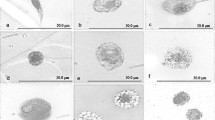Abstract
Monoclonal and polyclonal antibodies that bind to eggs and/or second-stage juveniles of the nematode Meloidogyne javanica were tested for their effects on the parasitic interactions between this nematode and the fungus Trichoderma. Parasitism of Trichoderma asperellum-203 and Trichoderma atroviride on nematode egg masses, eggs and juveniles was enhanced when antibodies were incorporated into in vitro parasitism bioassays. Parasitism on separated eggs (without gelatinous matrix) and their hatched juveniles was also improved, compared to controls without antibodies that did not attach fungal conidia. Improved parasitism could be due to bilateral binding of the antibodies to the nematodes and conidia, enabling better conidial attachment to the nematodes. Enhanced germination of antibody-bound conidia further improved parasitism. Differences were observed among antibodies in their effects on fungal parasitism and their interaction with Trichoderma species. We focused mainly on the egg- and juvenile-binding monoclonal antibody MISC that exhibited a stronger reaction with T. asperellum-203 than with T. atroviride. Pretreatment of this antibody with fucose inhibited its binding to nematodes and conidial attachment to nematodes, as well as conidial agglutination in the presence of the antibody. Antibody binding to juveniles affected their movement and viability, especially gelatinous matrix-originated juveniles. The fucose-specific lectin Ulex europaeus-I enhanced conidial attachment to nematode life-stages, and conidial agglutination occurred in its presence. These phenomena were inhibited by preincubating lectin with fucose. Our results suggest that carbohydrate residues, such as fucose, on the surface of the nematode and fungal conidia are involved in the antibody- and lectin-mediated improved parasitism.





Similar content being viewed by others
Abbreviations
- gm:
-
gelatinous matrix
- J2:
-
second-stage juvenile
- MAb:
-
monoclonal antibody
- PAb:
-
polyclonal antibody
References
Blaxter, M. L. & Robertson, W. M. (1998). The cuticle. In R. N. Perry & D. J Wright (Eds.), Free-living and plant parasitic nematodes (pp. 25–48). CAB International.
Davies, K. (2005). Interactions between nematodes and microorganisms: bridging ecological and molecular approaches. Advances in Applied Microbiology, 37, 53–78. doi:10.1016/S0065-2164(05)57002-3.
Elad, Y., Barak, R., & Chet, I. (1983). Possible role of lectins in mycoparasitism. Journal of Bacteriology, 154, 1431–1435.
Gravato-Nobre, M. J., & Evans, K. (1998). Plant and nematode surfaces: Their structure and importance in host–parasite interactions. Nematologica, 44, 103–124.
Gravato-Nobre, M. J., McClure, M. A., Dolan, L., Calder, G., Davies, K. G., Mulligan, B., et al. (1999). Meloidogyne incognita surface antigen epitopes in infected Arabidopsis roots. Journal of Nematology, 31, 212–223.
Harman, G. E., Howell, C. R., Viterbo, A., Chet, I., & Lorito, M. (2004). Trichoderma spp.—opportunistic avirulent plant symbionts. Nature Reviews Microbiology, 2, 43–56. doi:10.1038/nrmicro797.
Hu, G. G., McClure, M. A., & Schmitt, M. E. (2000). Origin of a Meloidogyne incognita surface coat antigen. Journal of Nematology, 32, 174–182.
Kerry, B. R. (2000). Rhizosphere interactions and exploitation of microbial agents for the biological control of plant–parasitic nematodes. Annual Review of Phytopathology, 38, 423–441. doi:10.1146/annurev.phyto.38.1.423.
Kerry, B. R., & Hominick, W. M. (2001). Biological control. In D. L. Lee (Ed.), Biology of Nematodes (pp. 483–509). London: Taylor and Francis.
Lin, H., & McClure, M. A. (1996). Surface coat of Meloidogyne incognita. Journal of Nematology, 28, 216–224.
Lopez de Mendoza, M. E., Curtis, R., & Gowen, S. (1999). Identification and characterization of excreted-secreted products and surface coat antigens of animal– and plant–parasitic nematodes. Parasitology, 118, 397–405. doi:10.1017/S0031182098003941.
Manzanilla-Lopez, R. H., Kenneth, E., & Bridge, J. (2004). Plant diseases caused by nematodes. In Z. X. Chen, S. Y. Chen, & D. W. Dickson (Eds.), Nematology—Advances and perspectives, Volume II: Nematode management and utilization (pp. 637–716). Cambridge, MA: CABI Publishing.
Morton, C. O., Hirsch, P. R., & Kerry, B. (2004). Infection of plant–parasitic nematodes by nematophagous fungi—a review of application of molecular biology to understand infection processes and to improve biological control. Nematology, 6, 161–170. doi:10.1163/1568541041218004.
Puyesky, M., Benhamou, N., Ponce Noyola, P., Bauw, G., Ziv, T., Van Montagu, M., et al. (1999). Developmental regulation of cmp1, a gene encoding a multidomain conidiospore surface protein of Trichoderma. Fungal Genetics and Biology, 27, 88–99. doi:10.1006/fgbi.1999.1134.
Sharon, E., Bar-Eyal, M., Chet, I., Herrera-Estrella, A., Kleifeld, O., & Spiegel, Y. (2001). Biocontrol of the root-knot nematode Meloidogyne javanica by Trichoderma harzianum. Phytopathology, 91, 687–693. doi:10.1094/PHYTO.2001.91.7.687.
Sharon, E., Chet, I., Viterbo, A., Bar-Eyal, M., Nagan, H., Samuels, G. J., et al. (2007). Parasitism of Trichoderma on Meloidogyne javanica and role of the gelatinous matrix. European Journal of Plant Pathology, 118, 247–258. doi:10.1007/s10658-007-9140-x.
Sharon, E., Spiegel, Y., Solomon, R., & Curtis, R. (2002). Characterization of Meloidogyne javanica surface coat using antibodies and their effect on nematode behaviour. Parasitology, 125, 177–185. doi:10.1017/S0031182002001907.
Spiegel, Y., Inbar, J., Kahane, I., & Sharon, E. (1995). Carbohydrate-recognition domains on the surface of phytophagous nematodes. Experimental Parasitology, 80, 220–227. doi:10.1006/expr.1995.1027.
Spiegel, Y., Kahane, I., Cohen, L., & Sharon, E. (1997). Meloidogyne javanica surface proteins: characterization and lability. Parasitology, 115, 513–519. doi:10.1017/S0031182097001637.
Spiegel, Y., & McClure, M. A. (1995). The surface coat of plant–parasitic nematodes: Chemical composition, origin and biological role. A review. Journal of Nematology, 27, 127–134.
Spiegel, Y., Mor, M., & Sharon, E. (1996). Attachment of Pasteuria penetrans endospores to the surface of Meloidogyne javanica second-stage juveniles. Journal of Nematology, 28, 328–334.
Acknowledgements
The authors thank Dr. Rosane Curtis, Department of Plant Pathogen Interactions, Rothamsted Research Limited, Harpenden, UK, and Prof. Michael A. McClure, Division of Plant Pathology and Microbiology, College of Agriculture and Life Sciences, Tucson, AZ, for kindly providing antibodies used in this study.
Author information
Authors and Affiliations
Corresponding author
Rights and permissions
About this article
Cite this article
Sharon, E., Chet, I. & Spiegel, Y. Improved attachment and parasitism of Trichoderma on Meloidogyne javanica in vitro. Eur J Plant Pathol 123, 291–299 (2009). https://doi.org/10.1007/s10658-008-9366-2
Received:
Accepted:
Published:
Issue Date:
DOI: https://doi.org/10.1007/s10658-008-9366-2




